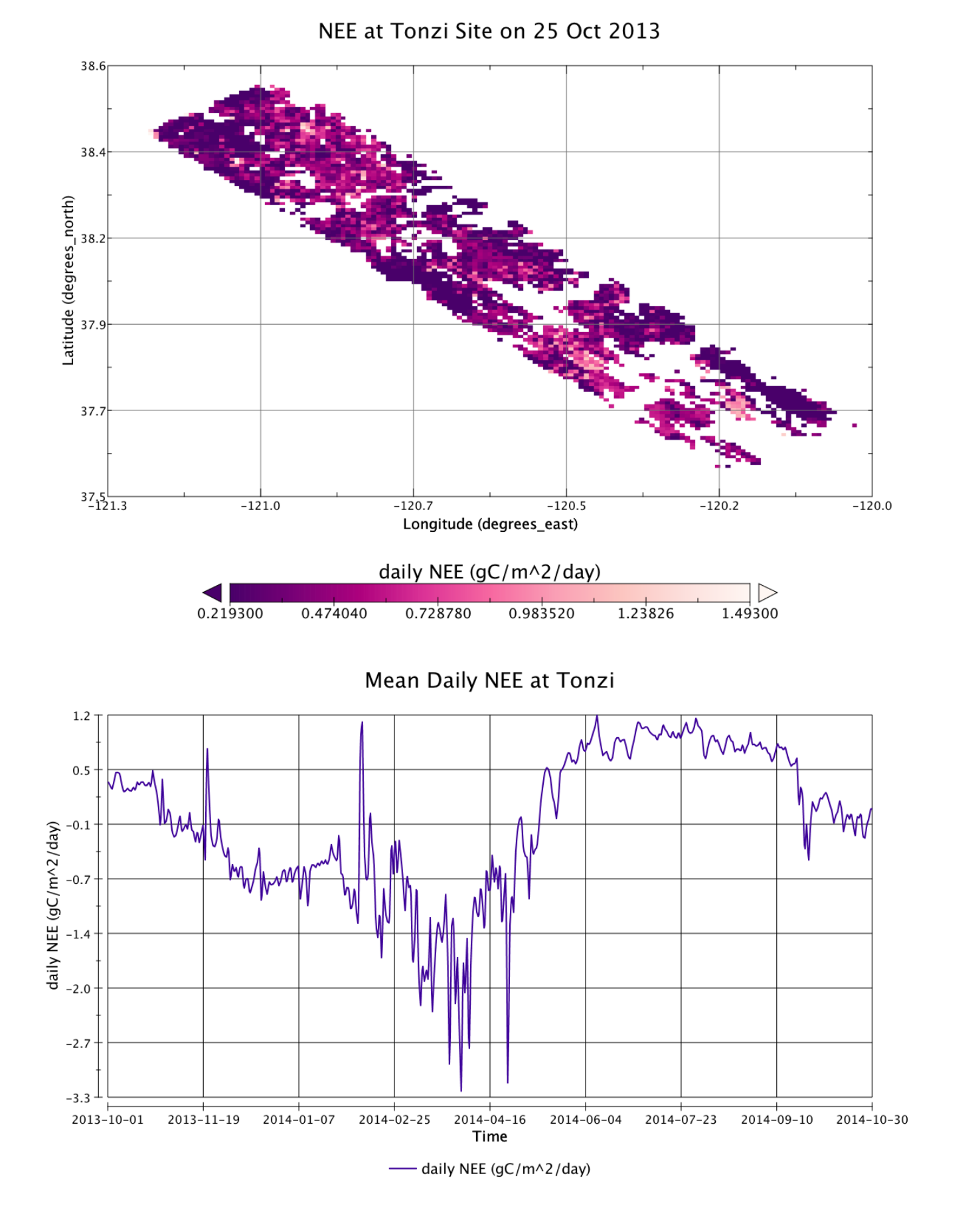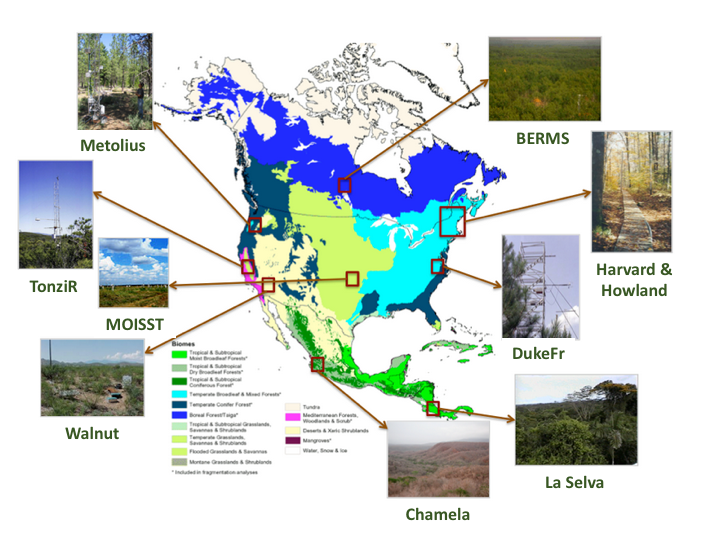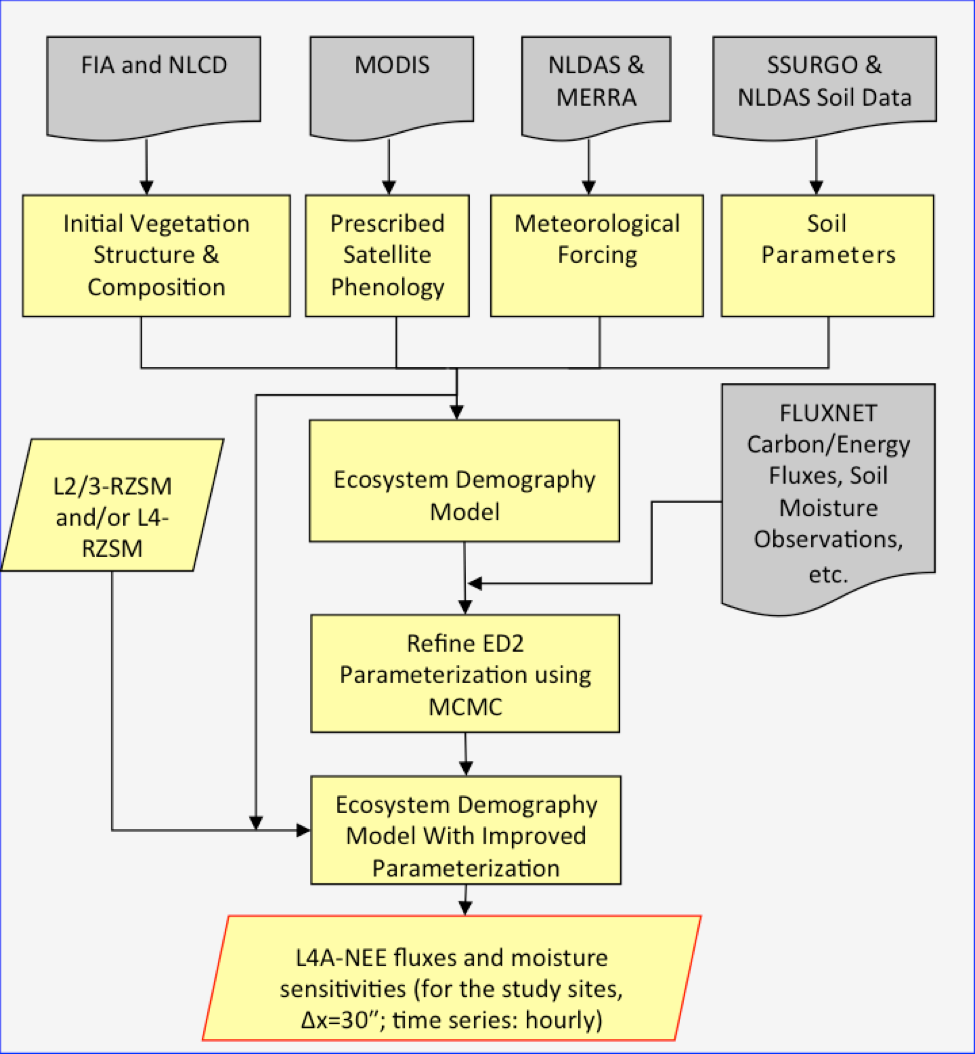Documentation Revision Date: 2016-11-21
Data Set Version: V1
Summary
This data set includes 7 files in netCDF (*.nc4) format. Each file contains the estimated L4 daily NEE at a particular site over the entire sampling period. The algorithm theoretical basis document (ATBD) for this data product is included as a companion file.

Figure 1: Spatial and temporal variability in Net Ecosystem Exchange (NEE) of CO2 at the Tonzi Ranch site.
Citation
Zhang, K., A.A. Ali, A. Antonarakis, and P.R. Moorcroft. 2016. AirMOSS: L4 Daily Modeled Net Ecosystem Exchange (NEE), AirMOSS sites, 2012-2014. ORNL DAAC, Oak Ridge, Tennessee, USA. http://dx.doi.org/10.3334/ORNLDAAC/1422
Table of Contents
- Data Set Overview
- Data Characteristics
- Application and Derivation
- Quality Assessment
- Data Acquisition, Materials, and Methods
- Data Access
- References
Data Set Overview
This data set provides Level 4 daily estimates of Net Ecosystem Exchange (NEE) of CO2 at a spatial resolution of 30 arc-seconds (~1 km) for seven of the sites covered by the Airborne Microwave Observatory of Subcanopy and Subsurface (AirMOSS) flights, each site spanning ~2500 km2. The daily NEE estimates are generally available from October 2012 through October 2014, although the exact time ranges vary by site. The AirMOSS L4 daily NEE were produced by the Ecosystem Demography Biosphere Model (ED2) augmented by the AirMOSS-derived L2/3 root zone soil moisture data as an additional input. The AirMOSS soil moisture data were used to estimate the sensitivity of carbon fluxes to soil moisture and to diagnose and improve estimation and prediction of NEE by constraining the model's predictions of soil moisture and its impact on above- and below-ground fluxes.
Project: Airborne Microwave Observatory of Subcanopy and Subsurface (AirMOSS)
The goal of NASA’s Airborne Microwave Observatory of Subcanopy and Subsurface (AirMOSS) investigation is to provide high-resolution observations of root-zone soil moisture over regions representative of the major North American climatic habitats (biomes), quantify the impact of variations in soil moisture on the estimation of regional carbon fluxes, and extrapolate the reduced-uncertainty estimates of regional carbon fluxes to the continental scale of North America.
- The AirMOSS campaign used an airborne ultra-high frequency synthetic aperture radar flown on a Gulfstream-III aircraft to derive estimates of soil moisture down to approximately 1.2 meters.
- Extensive ground, tower, and aircraft in-situ measurements were collected to validate root-zone soil measurements and carbon flux model estimates.
The AirMOSS soil measurements can be used to better understand carbon fluxes and their associated uncertainties on a continental scale. Additionally, AirMOSS data provide a direct means for validating root-zone soil measurement algorithms from the Soil Moisture Active & Passive (SMAP) mission and assessing the impact of fine-scale heterogeneities in its coarse-resolution products.
Related Data:
The following AirMOSS data were directly used to generate this data:
Moghaddam, M., A. Tabatabaeenejad, R.H. Chen, S.S. Saatchi, S. Jaruwatanadilok, M. Burgin, X. Duan, and M.L. Truong-Loi. 2016. AirMOSS: L2/3 Volumetric Soil Moisture Profiles Derived From Radar, 2012-2015. ORNL DAAC, Oak Ridge, Tennessee, USA. http://dx.doi.org/10.3334/ORNLDAAC/1418
A full list of AirMOSS data products is available at: https://airmoss.ornl.gov/dataproducts.html.
Data Characteristics
Spatial Coverage: Seven AirMOSS sites across North America
Spatial Resolution: 30 arc-seconds (~1 km)
Temporal Coverage: Most sites have data from October 2012 through October 2014, although the exact time range varies by site.
Temporal Resolution: Daily
Study Area (coordinates in decimal degrees)
|
Site |
Westernmost Longitude |
Easternmost Longitude |
Northernmost Latitude |
Southernmost Latitude |
|
North America |
-122.88 |
-68.33 |
45.78 |
31.49 |
Table 1. AirMOSS sites where L4 Daily NEE data were estimated. Three additional AirMOSS sites at La Selva, Costa Rica, BERMS, Saskatchewan, Canada, and Chamela, Mexico, do not have L4 Daily NEE data.
|
Site name |
North latitude |
South latitude |
East longitude |
West longitude |
Fluxnet Site ID |
Description |
|
DukeFr |
36.368 |
35.437 |
-78.694 |
-79.849 |
US-Dk1,US-Dk2, US-Dk3 |
Duke Forest site, North Carolina, USA. Landcover: Mature oak-hickory dominated hardwood forest. Elevation: 169m. |
|
Harvrd |
43.376 |
42.293 |
-71.839 |
-72.389 |
US-Ha1 & US-Ha2 |
Harvard Forest site, Massachusetts, USA. Landcover: Temperate deciduous forest. Elevation: 353m. |
|
Howlnd |
45.778 |
44.669 |
-68.336 |
-69.086 |
US-Ho1, US-Ho2, US-Ho3 |
Howland Forest site, Maine, USA. Landcover: boreal - northern hardwood transitional forest. Elevation 72m. |
|
Metoli |
45.242 |
43.38 |
-120.363 |
-123.283 |
US-Me1 to US-Me6 |
Metolius site, Oregon, USA. Landcover: evergreen needleleaf forest. Elevation 1237m. |
|
Moisst |
36.880 |
35.775 |
-96.824 |
-98.996 |
US-ARM |
The Marena, Oklahoma In Situ Sensor Testbed (MOISST) is located in Oklahoma, USA. Landcover: temperate grasslands, crops. Elevation: 312m. |
|
TonziR |
38.625 |
37.501 |
-120.001 |
-121.25 |
US-Ton |
Tonzi Ranch site, California, USA. Landcover: oak savanna and grazed grassland. Elevation 170m. |
|
Walnut |
32.125 |
31.501 |
-109.376 |
-111.5 |
US-Wkg & US-Whs |
Walnut Gulch site, Arizona, USA. Landcover: warm season C4 grassland with a few shrubs. Elevation 1524m. |
Data File Information
This data set includes 7 files in netCDF (*.nc4) format. Each file contains the estimated L4 daily NEE at a particular site over the entire sampling period. The algorithm theoretical basis document (ATBD) for this data product is included as a companion file (AirMOSS_L4NEE_ATBD_V2.0_160928.pdf).
File naming convention
AirMOSS L4 Daily NEE data file names have the format:
L4ANEE_AssmltdL23_sssss_vv_daily.nc4
where:
sssss = 6-character sitename where data was acquired
vv = version number
Example file name:
L4ANEE_AssmltdL23_Tonzi_v1_daily.nc4
Table 2. Data fields in the L4A Daily NEE data files. Missing data are represented by -999.
|
Data Field |
Units |
Description |
|
lat |
degrees North |
Latitude of grid cell |
|
lon |
degrees East |
Longitude of grid cell |
|
time |
days since 2010-01-01 00:00:00 UTC |
Date of modeled output |
|
NEE |
gC/m^2/day |
Net ecosystem exchange of CO2 per grid cell |
Application and Derivation
The AirMOSS data products and expected science results are tailored to meet the need to reduce uncertainty in estimates of net ecosystem exchange (NEE) through the development of methodologies to integrate remote sensing observations, in-ground soil sensors, and flux tower data into regional/continental flux models. Additionally, AirMOSS data provide a direct means for evaluating RZSM algorithms of the SMAP Decadal Survey mission and assessing the impact of fine-scale heterogeneities in its coarse-resolution products.
Quality Assessment
A key science objective of AirMOSS is a quantitative understanding of the impact of root-zone soil moisture on ecosystem carbon fluxes. The sensitivity of carbon flux to changes in soil moisture was calculated by comparing between ED2 model simulations that did, or did not, make use of AirMOSS soil moisture data. These comparisons are shown in the ATBD document for this data product.
Data Acquisition, Materials, and Methods
The goal of the Airborne Microwave Observatory of Subcanopy and Subsurface (AirMOSS) investigation is to provide high-resolution observations of root-zone soil moisture over regions representative of the major North American climatic habitats (biomes), quantify the impact of variations in soil moisture on the estimation of regional carbon fluxes, and extrapolate the reduced-uncertainty estimates of regional carbon fluxes to the continental scale of North America.
AirMOSS Flights
For AirMOSS, NASA's Uninhabited Aerial Vehicle Synthetic Aperture Radar (UAVSAR) was flown on a Gulfstream-III aircraft, making frequent flights over ten sites (Figure 2) in 9 different biomes of North America over the course of four years (Chapin et al. 2012).

Figure 2. AirMOSS study sites were co-located with flux towers in nine different biomes across North America.
Beginning in September 2012, the AirMOSS instrument flew 215 flight campaigns. A summary of flight campaigns by year and site is found in Table 3. Typically, the aircraft made repeat visits to sites in the same region in a single week and then proceeded to another region. Most sites had at least three campaigns per year. The Harvard and Howland forest sites were flown together in a single day. In 2012, Chamela, La Selva, and Tonzi were not surveyed.
Table 3. Summary of AirMOSS flight campaigns.
|
Site |
||||||||||
|
Year |
BermsP |
Chamel |
DukeFr |
Harvrd |
Howlnd |
LaSelv |
Metoli |
Oklaho |
TonziR |
Walnut |
|
2012 |
3 |
0 |
3 |
3 |
3 |
0 |
4 |
3 |
0 |
3 |
|
2013 |
6 |
3 |
9 |
9 |
9 |
6 |
7 |
8 |
5 |
6 |
|
2014 |
7 |
3 |
10 |
9 |
9 |
3 |
9 |
9 |
6 |
5 |
|
2015 |
9 |
2 |
5 |
5 |
5 |
3 |
9 |
6 |
5 |
6 |
|
Total |
25 |
8 |
27 |
26 |
26 |
12 |
29 |
26 |
16 |
20 |
A complete list of AirMOSS flights can be found at: https://airmoss.ornl.gov/flights.html.
AirMOSS Level 4A Daily NEE Data Product
Root-zone soil moisture and its spatial and temporal heterogeneity influences NEE. The AirMOSS L4A NEE data were produced by the Ecosystem Demography Model (ED2), augmented by inputs from AirMOSS L2/3 RZSM data. Specifically, the AirMOSS L2/3 RZSM data were used to estimate the sensitivity of carbon fluxes to soil moisture and to diagnose and improve estimation and prediction of NEE in ED2.
The Ecosystem Demography Biosphere Model (ED2) is an integrated terrestrial biosphere model incorporating hydrology, land-surface biophysics, vegetation dynamics, and soil carbon and nitrogen biogeochemistry (Medvigy et al. 2009). The inputs include: meteorological forcing data, soil properties information, definition of initial ecosystem structure and composition, and prescribed phenology data regarding the timing of leaf flush and leaf drop. AirMOSS L2/3 soil moisture data were used to constrain the model’s predictions of soil moisture and its impact on above- and below-ground fluxes, as described Figure 3 below, and in the algorithm theoretical basis document (ATBD) for this data product, included with this data set, AirMOSS_L4NEE_ATBD_V2.0_160928.pdf.

Figure 3. Flowchart describing the inputs, forcings, and initial conditions needed to produce the L4A-NEE products from the ED2 model.
Data Access
These data are available through the Oak Ridge National Laboratory (ORNL) Distributed Active Archive Center (DAAC).
AirMOSS: L4 Daily Modeled Net Ecosystem Exchange (NEE), AirMOSS sites, 2012-2014
Contact for Data Center Access Information:
- E-mail: uso@daac.ornl.gov
- Telephone: +1 (865) 241-3952
References
Chapin, E., A. Chau, J. Chen, B. Heavey, S. Hensley, Y. Lou, R. Machuzak, and M. Moghaddam. 2012. AirMOSS: An Airborne P-band SAR to measure root-zone soil moisture, 2012 IEEE Radar Conference, Atlanta, GA, 2012, pp. 0693-0698. http://dx.doi.org/10.1109/RADAR.2012.6212227
Medvigy, D, SC Wofsy, J.W. Munger, D.Y. Hollinger and P.R. Moorcroft (2009). Mechanistic scaling of ecosystem function and dynamics in space and time: the Ecosystem Demography model version 2, Journal of Geophysical Research – Biogeosciences, 114(G1). http://dx.doi.org/10.1029/2008JG000812